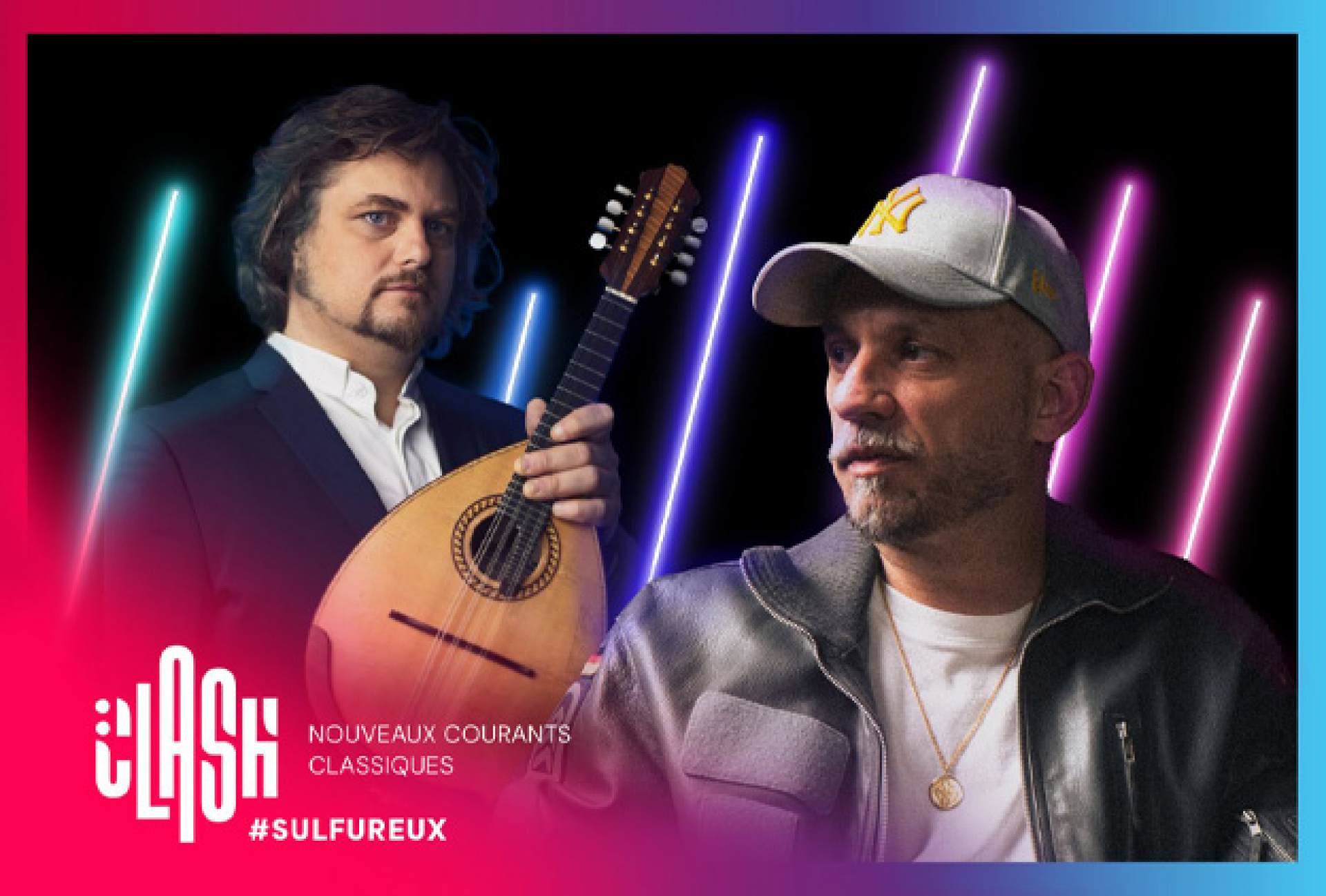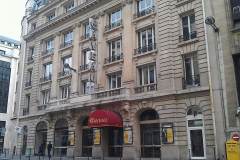Dooz Kawa Orchestra
Mo | Tu | We | Th | Fr | Sa | Su |
Rapper Dooz Kawa is about to unveil a new work, much more than just an album: a real "opus". This ambitious project ventures off the beaten track of hip-hop to explore the worlds of classical and baroque music. Accustomed to handling words with finesse and precision, Dooz Kawa teams up with musical virtuosos to bring his vision to life. For this exceptional evening, he will be accompanied by virtuoso mandolinist Vincent Beer-Demander and the string ensemble 1001 Notes. Together, they invite us on a unique musical journey where rap mixes with classical music, creating a one-of-a-kind symphony. This is not the first time that Dooz Kawa has collaborated with extraordinary artists. He has already shared the stage with talents such as Biréli Lagrène, Mandino Reinhardt and Levon Minassian. This new musical adventure once again demonstrates his audacity and his desire to push the boundaries of his art. What does this new opus have in store for us? The surprise is total. But one thing is certain: Dooz Kawa promises us an extraordinary musical experience, where words and notes intertwine to create an unforgettable symphony.
Program and cast
Interpreters
Dooz Kawa: rap
Vincent Beer-Ask for: Mandolin
Quintet 1001 Notes
Salle Gaveau
The Salle Gaveau, named after the French piano maker Gaveau, is a classical concert hall in Paris, located at 45-47 rue La Boétie, in the 8th arrondissement of Paris. It is particularly intended for chamber music.
Construction
The plans for the hall were drawn up by Jacques Hermant in 1905, the year the land was acquired. The construction of the Gaveau building took place from 1906 to 1907. The vocation of this hall was chamber music from the beginning, and its seating capacity was a thousand, just as it is today. The hall was home to a large organ built in 1900 by the Cavaillé-Coll|Mutin-Cavaillé-Coll firm. This instrument with 39 stops (8 on the positive, 12 on the recitative, 12 on the grand organ and 7 on the pedal) was subsequently installed in 1957 in the commune of Saint-Saëns in Normandy. The hall is a concert venue renowned for its exceptional acoustics.
The room
In some 110 years, the Salle Gaveau has established itself in the Parisian musical landscape as an essential music venue. Find out the important dates of this hall full of history which has hosted the greatest pianists of the 20th century.
1905 - 1907
BIRTH OF THE GAVEAU ROOM
The land on which the Gaveau building is built was acquired in 1905. The plans for the hall were drawn up with particular attention to acoustics at the end of 1905 by the architect Jacques Hermant . The building was built in 1906-1907 and the Gaveau hall was immediately the prestigious hall in Paris. Its main purpose has always been piano and chamber music but orchestras were often heard there. The number of seats has changed slightly over time to around 1000 seats . The current number is 1020.
1907 - 1908
PROMISING BEGINNINGS
The Salle Gaveau opened its doors for the 1907-1908 season. The first concert was given on October 3, 1907 by the Bremer Lehrergesangverein . It was a vocal concert given with 140 performers. Thus, despite its average dimensions, the Salle Gaveau was not afraid to welcome large groups and it can be noted that from this season onwards, it hosted the Lamoureux concerts which gave concerts there under the direction of Camille Chevillard , Vincent D'Indy , and André Messager .
The 1907-1908 season was very brilliant in the field of chamber music. Cortot, Thibaud and Casals performed the complete Beethoven trios and trio variations there on November 5, 8 and 12. Eugène Ysaye gave a recital there on January 21, 1908. Marguerite Long performed there on December 11, 1911.
1912
ENESCO, KREISLER, CORTOT...
In the field of chamber music , some superb concerts in 1912: Enesco on February 8 with the pianist Eugène Wagner. Fritz Kreisler on April 21 and 28, Wilhelm Backaus on May 15, Cortot, Thibaud and Casals on May 24 and 31.
1933 - 1934
LAMOUREUX AND PASDELOUP CONCERTS
The war did not interrupt the artistic activity of the Salle Gaveau but the hall was used for galas given for the benefit of soldiers or victims of the war.
After the war the hall had a very brilliant period with the Lamoureux and Pasdeloup concerts . Great conductors conducted there: Charles Munch on October 28, 1933.
The great pianist Rudolph Serkin performed on December 2, 1933. Wanda Landowska gave a recital on a Pleyel harpsichord on November 7, 1933. Yves Nat performed Beethoven's sonatas in 1934.
1939 - 1944
A TROUBLED PERIOD
During the Second World War, the hall rediscovered its vocation to host galas.
Berthe Bovy recited fables by La Fontaine .
During the occupation, great soloists were heard: Paul Tortelier, Pierre Fournier, Raymond Trouard, Jacques Fevrier . From 1944, Samson François performed regularly. Germaine Lubin sang melodies accompanied on the piano by Reynaldo Hahn .
1976
RESUMPTION OF THE ROOM BY C. AND JM FOURNIER
Only the bankruptcy of the Gaveau house, which occurred in 1963, came to shake its sustainability...
The building, partly resold to an insurance company, soon lost its splendor. Under pressure from land, the hall escaped in extremis the threat of a parking lot thanks to the saving energy of Chantal and Jean-Marie Fournier , a couple of passionate musicians, who acquired it in 1976 and have kept it alive for 25 years.
1992
THE ROOM CLASSIFIED AS A HISTORICAL MONUMENT
Listed in the inventory in 1982, classified in 1992 in the wake, Gaveau was saved from the worst but in pitiful condition. "Everything was very tired and we were beginning to fear that a seat would give way in the middle of a performance", testify the masters on board who sounded the alarm in order to obtain subsidies for the restoration.
The work, conducted under the direction of the chief architect of historic monuments, Alain Charles Perrot (already officiating on the Paris Opera), aims to restore listening comfort without affecting the unique sound of the hall, the secret of its success.
2001
THE RENOVATION FINALLY COMPLETED
If the sound remains, the tone changes: "The spectators will be very surprised to discover the original stripping and sobriety of this modern room ahead of its time", explains Alain Charles Perrot. The architect has tried to rediscover the strict gray with gold accents of the historical decor, and the originality of the lighting, its bare bulbs "like pearls on the ceiling". Reconstructed identically , the armchairs with metal legs and wooden frames reconnect with the original buttercup yellow.
Restored to its truth, Gaveau is banking on increased attractiveness to seduce a new audience, including companies in the "golden triangle" for private parties. The future of this high-end room is based on a healthy complementarity of activities, always with music shared. The room reopens its doors on January 8, 2001. A reopening concert is then a landmark, with the great Roberto Alagna
on the bill .

 EN
EN DE
DE IT
IT FR
FR ES
ES RU
RU JP
JP RO
RO
 Seating plan
Seating plan 